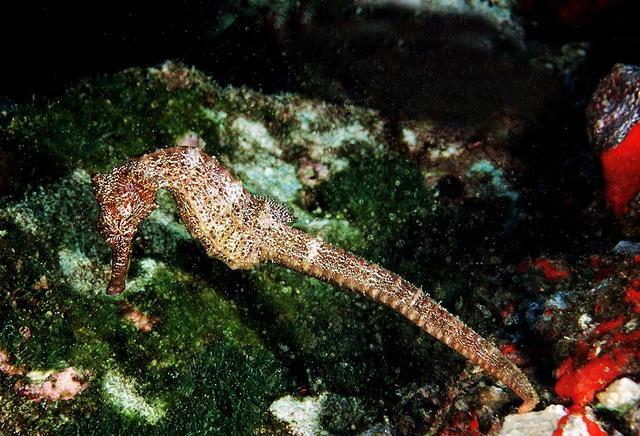 "A male that gets
pregnant"
"A male that gets
pregnant"

The Pacific Seahorse has an unique
reproduction cycle. Instead of the female carrying around the eggs, the male
carries the eggs around in a pouch. The mating ritual starts out by the male
dancing around the female; he produces clicking sounds with his skull as the
female and male start to change their vibrant colors. (To watch a video on a
courtship ritual
click here)
The actual mating occurs when the female points
 her tail down and her nose up
toward the surface, the male pulls his tail back and propels water in
and out of a pouch that is located on his belly. Once the pouch is cleaned, the
male swims close to the female and they face belly-to-belly to interlock one
another. This is when the female puts her ovipositor (a tube that places large
sticky eggs) into the maleís pouch. The male releases sperm inside the pouch to
fertilize the eggs.
her tail down and her nose up
toward the surface, the male pulls his tail back and propels water in
and out of a pouch that is located on his belly. Once the pouch is cleaned, the
male swims close to the female and they face belly-to-belly to interlock one
another. This is when the female puts her ovipositor (a tube that places large
sticky eggs) into the maleís pouch. The male releases sperm inside the pouch to
fertilize the eggs.
Each morning the male and female meet and perform the
courtship ritual of dancing, changing color and intertwining their tails.
When the eggs are ready to hatch, 10 to 45 days later,
the male contracts his pouch to help the fry (baby seahorse) find their way out
of the pouch. There are about 100 to 200 seahorses born at a time and each one
is 6 mm to 12 mm long. The fry look like a miniature version of an adult
seahorse and are entirely independent as soon as they leave the fatherís pouch.
(To watch a video on the birth of the fry
click here.)
The female seahorse returns the following morning to deposit another set of
eggs inside the male seahorse and the cycle starts all over again. Males are
able to become pregnant because they produce the female hormone, prolactin.
Many of the courtship rituals are influenced by the
tides, lunar cycles and the changing of the seasons.
Picture above taken by Clay Bryce